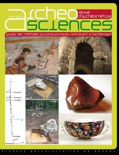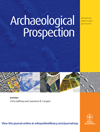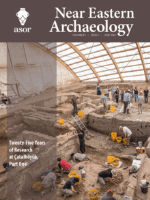
ArcheoSciences-Revue d Archeometrie
Scope & Guideline
Decoding History: Where Science Meets Archaeology
Introduction
Aims and Scopes
- Archaeological Methodologies:
The journal emphasizes the use of innovative archaeological methodologies, including geophysical surveys, ground-penetrating radar (GPR), and photogrammetry, to uncover and analyze archaeological sites. - Material Analysis:
A core area of focus is the analysis of materials used in ancient artifacts and structures, including ceramics, metals, and organic materials, employing techniques such as neutron tomography and chemical studies. - Environmental and Landscape Archaeology:
The journal explores how past human activities interacted with their environments, utilizing stratigraphy and sediment analysis to understand landscape evolution and anthropogenic impacts. - Interdisciplinary Approaches:
A unique contribution of the journal is its promotion of interdisciplinary research that combines archaeological data with geophysical, geological, and chemical analyses to provide comprehensive insights into historical contexts. - Cultural Heritage and Preservation:
The journal addresses contemporary issues in cultural heritage, including the preservation of archaeological sites and the impact of modern activities on ancient landscapes.
Trending and Emerging
- Multisource Analytical Techniques:
Recent publications highlight a growing trend towards using multisource analytical techniques, combining data from various methods such as GPR, electromagnetic induction, and chemical analysis to enhance archaeological interpretations. - Environmental Impact Studies:
There is an increasing focus on understanding the environmental impacts of past human activities, as evidenced by studies on landscape evolution and anthropization, which are crucial for contextualizing archaeological findings. - Digital Archaeology and Data Integration:
Emerging themes include the use of digital tools and data integration techniques, such as machine learning and deep neural networks, to analyze archaeological data and improve survey methodologies. - Preservation and Conservation Techniques:
The journal is seeing a rise in studies exploring innovative preservation and conservation techniques, particularly regarding the degradation of archaeological materials and the impacts of climate change. - Community Engagement and Public Archaeology:
There is an emerging interest in community engagement and public archaeology, focusing on how archaeological research can involve local communities and enhance public understanding of heritage.
Declining or Waning
- Traditional Excavation Techniques:
There has been a noticeable decrease in publications focusing solely on traditional excavation methods, as the field increasingly favors non-invasive techniques and technological advancements. - Historical Archaeology of Specific Regions:
Research centered on specific historical contexts or regions, such as localized studies of ancient civilizations, appears to be waning in favor of broader, comparative analyses and interdisciplinary studies. - Descriptive Studies of Artifacts:
The journal has seen a reduction in purely descriptive studies of artifacts, with a shift towards analytical studies that incorporate scientific methodologies to derive deeper insights.
Similar Journals

Archaeological Prospection
Advancing Methodologies: Shaping the Future of ArchaeologyArchaeological Prospection, published by WILEY, is an esteemed journal dedicated to advancing the field of archaeology through innovative research and methodologies. With an ISSN of 1075-2196 and an E-ISSN of 1099-0763, this journal has established a significant presence since its inception in 1994, converging its influential findings until 2024. Recognized for its high academic standards, it proudly holds a Q1 ranking in both Archaeology and History for 2023, reflecting its commitment to excellence with notable Scopus rankings that place it in the top tiers of both Arts and Humanities, and Social Sciences. By fostering rigorous scholarly dialogue and disseminating cutting-edge practices in archaeological prospection, this journal serves as an invaluable resource for researchers, professionals, and students alike, propelling collective understanding of our human past. Although it does not currently offer open access options, the depth and quality of research published within its pages remains crucial for those engaged in archaeological studies and historical exploration.

NEAR EASTERN ARCHAEOLOGY
Pioneering Insights into Archaeology and HistoryNEAR EASTERN ARCHAEOLOGY, published by University of Chicago Press, is a premier journal dedicated to the field of archaeology, particularly focusing on the rich cultural heritage and archaeological findings of the Near East. With an ISSN of 1094-2076 and an E-ISSN of 2325-5404, this esteemed publication provides a vital platform for scholars and practitioners to share their research, insights, and discoveries. The journal holds an impressive ranking in the Q1 quartile for both Archaeology and History in 2023, reflecting its significant impact within these fields and a robust history of scholarly contribution. The journal has been pivotal in shaping discussions around archaeological methodology, theory, and contemporary issues from 2002 to 2024, as it continues to reach a wide audience through various access options. With Scopus rankings placing it in the top percentiles for both History and Archaeology, NEAR EASTERN ARCHAEOLOGY represents an essential resource for researchers, professionals, and students alike, fostering the exploration and understanding of the region's archaeological narrative.

ARCHAEOLOGY IN OCEANIA
Advancing Archaeological Insights from the PacificARCHAEOLOGY IN OCEANIA, published by Wiley, is a leading journal that delves into the rich and diverse archaeological landscape of the Pacific region. With a commitment to advancing knowledge in anthropology and archaeology, this esteemed publication has been pivotal in shaping scholarly discussions since its inception in 1966. Spanning generations of research, it has seen converged years of publication from 1966 to 1980 and from 2002 to 2024. With an impressive Scopus ranking placing it in the top quartiles across multiple categories - including Q2 in Anthropology and Q1 in Archeology (arts and humanities) - the journal distinguishes itself as a must-read for researchers, professionals, and students alike. Although it operates on a subscription model, its rigorous peer-reviewed articles and comprehensive studies contribute significantly to understanding the past of Oceania, making it an essential resource for those invested in this vibrant field of study.

Virtual Archaeology Review
Bridging Heritage and Technology for a Sustainable Tomorrow.Virtual Archaeology Review, published by UNIV POLITECNICA VALENCIA, EDITORIAL UPV, is a distinguished open-access journal dedicated to the dynamic fields of archaeology and conservation. Based in Spain, this journal has made a significant impact in the academic community, reflected in its outstanding Q1 ranking in Archeology and Conservation for 2023, alongside impressive standings in related disciplines such as Computer Science Applications. With an active commitment to promoting the accessibility of knowledge since 2010, it provides a platform for researchers, professionals, and students to share innovative findings and methodologies in virtual archaeology, fostering collaboration across disciplines. The journal's impact factor and its strategic focus on advancing the practice of virtual methodologies in archaeology underscore its vital role in bridging technology and heritage studies. By embracing a multidisciplinary approach, Virtual Archaeology Review not only enhances academic discourse but also drives the development of effective conservation strategies, making it an essential resource for those dedicated to the preservation and appreciation of our cultural heritage.

Stratum Plus
Fostering Academic Excellence in the Heart of MoldovaStratum Plus, published by HIGH ANTHROPOLOGICAL SCH UNIV, is a distinguished academic journal based in Moldova that focuses on the fields of Anthropology, Archeology, and History. With an impressive impact factor reflecting its stature—ranked in the Q2 category for both Anthropology and Archeology, and Q1 for Archeology in the arts and humanities—this journal is a vital resource for scholars, professionals, and students alike. The journal's comprehensive scope encompasses a wide array of interdisciplinary studies, making it a beacon for innovative research and critical discourse within these disciplines. Since its inception in 2014, Stratum Plus has strived to foster academic excellence and knowledge dissemination, thus playing a crucial role in shaping contemporary anthropological and archaeological thought. While currently not available as Open Access, the journal maintains a strong online presence, with access options available through institutional subscriptions. Located at ZIMBRULUI 10A ST, KISHINEV MD-2024, MOLDOVA, Stratum Plus invites contributors and readers to engage with cutting-edge research that continues to enrich the global academic community.

Mediterranean Archaeology & Archaeometry
Exploring the Depths of Mediterranean HeritageMediterranean Archaeology & Archaeometry is a premier academic journal dedicated to advancing the fields of archaeology, anthropology, conservation, and history, published by UK Zhende Publishing Ltd. With its ISSN 1108-9628 and E-ISSN 2241-8121, this journal serves as a vital platform for scholars and practitioners to disseminate innovative research and findings related to the rich archaeological heritage of the Mediterranean region. It has gained remarkable recognition, achieving a Q2 ranking in anthropology and archaeology, and a Q1 classification in several categories including arts and humanities, conservation, and history as of 2023. Its impressive Scopus rankings underscore its impact, with a significant position in history (59/1760) and conservation (11/103) disciplines. Spanning years from 2008 to 2022, the journal invites open access contributions to foster collaboration and interdisciplinary dialogue among researchers, students, and professionals alike, making it an indispensable resource for those engaged in the exploration and preservation of historical narratives within the Mediterranean context.

Prilozi Instituta za Arheologiju u Zagrebu
Navigating the depths of archaeology for a brighter academic future.Prilozi Instituta za Arheologiju u Zagrebu is a prominent academic journal published by INST ARHEOLOGIJU, dedicated to advancing the field of archaeology and related historical studies. Operating in Croatia, this journal serves as a vital platform for scholars, researchers, and students to disseminate innovative research and insights within the realm of archaeology, with a focus on the rich cultural heritage of the region. The journal spans contributions from 2002 to 2011 and has ongoing publication since 2013, reflecting its commitment to contemporary archaeological discourse. With a growing reputation, it has achieved a Q3 ranking in the fields of Archaeology and Arts and Humanities, and a Q2 ranking in History, signifying its impact and relevance in the academic community. Although Open Access options are not available, the journal remains an essential resource for those pursuing in-depth knowledge and research in archaeology. Researchers can harness the journal's extensive scope to explore critical historical narratives and archaeological findings, solidifying its importance in both local and global contexts.

Annales Instituti Archaeologici
Advancing Archaeological Knowledge Through Rigorous ResearchAnnales Instituti Archaeologici is a distinguished journal published by INST ARHEOLOGIJU, dedicated to advancing research in the field of archaeology. With an ISSN of 1845-4046 and an E-ISSN of 1848-6363, this journal serves as a vital platform for the dissemination of innovative archaeological studies and findings, reflecting the evolving trends and methodologies in this fascinating discipline. Based in Croatia, the journal captures a global audience, emphasized by its Q3 ranking in both Archaeology categories as per the latest 2023 metrics, indicating a solid presence in the academic landscape. Although it does not currently offer Open Access options, its impactful contributions are recognized through its Scopus ranks, where it stands at #137/413 in Archaeology related to Arts and Humanities and #135/354 in Social Sciences. Researchers, professionals, and students interested in the latest archaeological research and its applications will find Annales Instituti Archaeologici to be an invaluable resource, promoting knowledge and fostering scholarly communication within the archaeological community.

Journal of Pacific Archaeology
Bridging Cultures Through Archaeological DiscoveryThe Journal of Pacific Archaeology, published by the New Zealand Archaeological Association, serves as a pivotal platform for disseminating cutting-edge research in the field of archaeology across the Pacific region. With an ISSN of 1179-4704 and an E-ISSN of 1179-4712, the journal provides a forum for scholarly discourse aimed at both established researchers and emerging scholars alike. Focusing on the rich tapestry of archaeological studies, it covers a diverse array of topics, from ancient settlement patterns and cultural practices to contemporary analyses of material culture. As an Open Access journal, it ensures that its findings are readily available to all, fostering inclusivity in academic research and enabling practitioners to share knowledge without barriers. The Journal of Pacific Archaeology is indispensable for those committed to understanding the complexities and nuances of Pacific archaeology, making significant contributions to both regional and global archaeological narratives.

AMERICAN ANTIQUITY
Preserving Knowledge, Inspiring Discovery.AMERICAN ANTIQUITY, published by Cambridge University Press, stands as a premier journal in the fields of archaeology, arts and humanities, history, and museology. With an enduring legacy since its inception in 1935, this journal has consistently ranked in the Q1 category across several disciplines, reflecting its significant impact and authority in shaping contemporary scholarly discourse. It boasts impressive Scopus rankings, placing it in the 99th percentile for archaeology and history, which underscores its critical role in advancing research and understanding of American archaeology and related fields. Although it does not currently offer open-access options, the journal remains a vital resource for researchers, professionals, and students seeking high-quality, peer-reviewed content. As it converges toward 2024, AMERICAN ANTIQUITY continues to foster innovative scholarship and preserve knowledge, making it an essential reading for anyone invested in the exploration of cultural heritage and historical narratives.